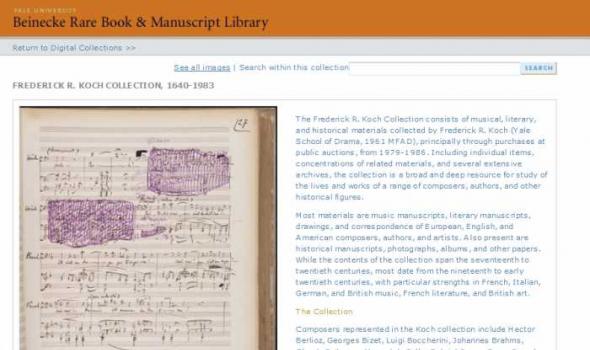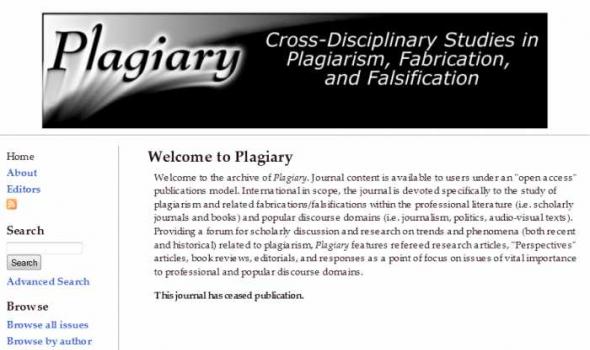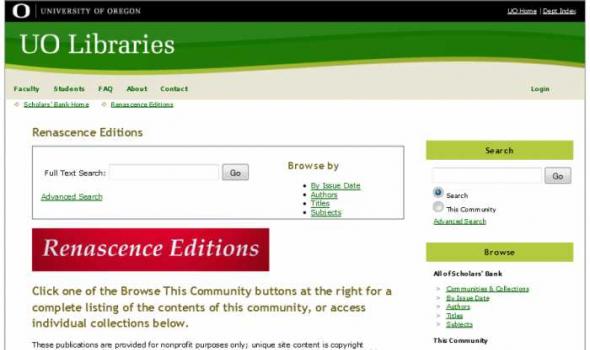Category: Yale University
Results
This collection draws together images from The Medieval Book, the catalogue of an exhibition held at the Beinecke Library in 1988 and curated by Vice-Provost Barbara Shailor. A celebration of the Beinecke Library?s extraordinary collection of medieval and Renaissance manuscripts, the exhibition examined the development, construction, and function of the book in the Middle Ages and Renaissance. The manuscript collections have been described extensively in the Catalogue of Medieval and Renaissance Manuscripts in the Beinecke Rare Book and Manuscript Library, Yale University , volumes 1-3 of which were edited by Barbara Shailor, and volume 4 of which was edited by Robert Babcock, Lisa Davis, and Philip Rusche.
The Collection The Beinecke Library’s Medieval and Renaissance collections document the history of human thought from the Byzantine era through 1600. The first medieval manuscript recorded in the Yale collection was acquired in 1714, and was the gift of Elihu Yale. An illustrated copy of the Speculum humanae salvationis , it attracted the special attention of Yale President Ezra Stiles, who read the manuscript and annotated it in the 1790s. The systematic collecting of medieval manuscripts at Yale, however, dates from the late nineteenth century, and the most active period for collecting was after 1930.
Pittsburgh native Walter McClintock graduated from Yale in 1891. In 1896 he traveled west as a photographer for a federal commission investigating national forests. McClintock became friends with the expedition’s Blackfoot Indian scout, William Jackson or Siksikakoan . When the commission completed its field work, Jackson introduced McClintock to the Blackfoot community of northwestern Montana. Over the next twenty years, supported by the Blackfoot elder Mad Wolf, McClintock made several thousand photographs of the Blackfoot, their homelands, their material culture, and their ceremonies.
The carte-de-visite, usually an albumen paper photograph mounted on a heavy paper card measuring 2½ × 4 inches, flourished in popularity between 1860 and the 1880s. The Carl Mautz collection of cartes-de-visite photographs created by California photographers includes 145 images consisting chiefly of portraits depicting children, women, and men, in single and group sittings and various ethnic and cultural backgrounds, including Asian American and African Americans. The portraits also include persons with unique physical features, including midgets, dwarves, and giants as well as butchers, circus performers, freemason, miners, musicians, sailors, and soldiers.
The Beinecke Library digitized 10,705 slides taken from a microfilm of F. T. Marinetti's seven Libroni or scrapbooks, compiled by Marinetti between 1905 and 1944, the year of his death. These scrapbooks contain thousands of newspaper clippings, journal articles, cartoons, drawings, photographs, manuscript items and other printed ephemera, which document Futurism and the avant-garde. The slides were acquired by the Library in 1999, along with a detailed listing of virtually every item depicted. That detailed listing is the source of the bibliographic data currently linked to each image. The Libroni database contains bibliographic errors, items lacking description, and image legibility and sequencing problems.
The Collection Cite as: Filippo Tommaso Marinetti Papers. General Collection, Beinecke Rare Book and Manuscript Library, Yale University Related: Filippo Tommaso Marinetti's Libroni 10,705 slides taken from a microfilm of F. T. Marinetti's seven Libroni or scrapbooks, compiled by Marinetti between 1905 and 1944, the year of his death. Share |
Mammoth plate photographs are photographic prints made through contact printing a photographic print from a large glass plate negative, usually 18 by 21 inches, but may vary in size from 15 by 18 inches to 22 by 25 inches. These large negatives allowed photographers to produce outsized photographic prints before the development of photographic enlargers. The collection consists of 57 black and white photographic prints roughly 21 x 17 inches Cite as: Mammoth Plate Photographs of the North American West. Yale Collection of Western Americana, Beinecke Rare Book and Manuscript Library. Call Number: WA Photos Folio 1
A writer, social activist, and arts aficionado, Mabel Dodge Luhan is celebrated less for her artistic accomplishments than for her key role in building artistic communities, supporting artists, and generating interest in modern art forms. A Buffalo, New York, native, she lived at the turn of the twentieth century in Florence, Italy, where she was a prominent figure among American expatriates and visitors that included Gertrude Stein, Carl Van Vechten, and Hutchins and Neith Boyce Hapgood. Returning to the United States in the 1910s, Mabel Dodge settled in Greenwich Village, where she helped organize the groundbreaking Armory show of Postimpressionist art and hosted perhaps the most important New York City salon of the period.
The collection consists of 105 items (86 lobby cards and 19 printed fliers) promoting sixty-eight films. Cite as: Western Silent Films Lobby Card Collection. Yale Collection of Western Americana, Beinecke Rare Book and Manuscript Library, Yale University Call Number: WA MSS S-2553
1968 September 11-1969 November 13 Alexander Lmanian (1925-1996) was a sergeant in the United States Army in World War II, and a part-time photographer for the New Haven Register newspaper and the Associated Press. This collection consists of photographs created by Alexander Lmanian documenting locations and events in Washington, D.C., and its vicinity, 1964-1968, as well as New Haven, Connecticut, 1968-1969. The images of Washington document the physical impact of riots on the city following the assassination of Martin Luther King, Jr., April 4-8, 1968, as well as events and memorials in the city and vicinity, 1967-1968.
The Frederick R. Koch Collection consists of musical, literary, and historical materials collected by Frederick R. Koch (Yale School of Drama, 1961 MFAD), principally through purchases at public auctions, from 1979-1986. Including individual items, concentrations of related materials, and several extensive archives, the collection is a broad and deep resource for study of the lives and works of a range of composers, authors, and other historical figures. Most materials are music manuscripts, literary manuscripts, drawings, and correspondence of European, English, and American composers, authors, and artists. Also present are historical manuscripts, photographs, albums, and other papers.
For the last decade of the nineteenth century and at least the first two decades of the twentieth, Rudyard Kipling (1865-1936) was one of the most popular writers in the English language, in both prose and verse. He was among the last British poets to command a mass audience, appealing to readers of all social classes and ages. Although his few novels, except Kim , were only a mixed success, in the medium of the short story Kipling extended the range of English fiction in both subject matter and technique and perhaps did more than any other author in the English language to blur the division between popular and high art. Rudyard Kipling: The Books I Leave Behind , an exhibition held in 2007, was the first comprehensive show to be presented anywhere in over fifty years.
Ketubah, marriage contract, manuscript, ink and paint on paper, 20th of Menahem 5671 [1911 August 14], Bombay, India The ketubah (plural ketubot ) is the standard marriage contract that Jewish law requires a groom to provide for his bride on their wedding day. It is intended to protect the woman, primarily by establishing the man's financial obligations to her in case of divorce or widowhood. In addition to the financial clauses, the text of the ketubah outlines other obligations undertaken by the groom, including traditional conjugal rights such as food, clothing and shelter. The exact date when the ketubah became a central part of the Jewish marriage ceremony remains unknown. It is a rabbinic institution, not a biblical one, and goes back to Talmudic times (70-500 C.E.).
[Autographed letter signed] 1905 July 12, Wyncote, Pennsylvania [from] Ezra Pound These materials may be under copyright. To learn more, contact the Curator, Yale Collection of American Literature. Call Number: YCAL MSS 175 Related Collections Ezra Pound Papers, YCAL MSS 43 William Carlos Williams papers, YCAL MSS 116 H. D. Papers, YCAL MSS 24 Bryher papers, GEN MSS 97
From the sixteenth through the nineteenth centuries, the royal and aristocratic courts behind Europe’s most illustrious festivals printed elaborate, illustrated volumes to record the celebrations that they organized to mark births, deaths, betrothals, weddings, coronations, and visits. Often circulated for the benefit of rival noble families and in the interests of self promotion, festival books are fascinating witnesses to aristocratic culture and art during the Early Modern period.
The Collection Just under 300 engravings, watercolors, and illustrations drawn from books, archival collections, and artwork from the Beinecke Library's Western Americana and General collections. Cite as: Beinecke Rare Book and Manuscript Library, Yale University
Portraits represent various tribal groups, including, among many others, the Apache Indians, Arapaho Indians, Arikara Indians, Bannock Indians, Cherokee Indians, Cheyenne Indians, , Oglala Indians, Ojibwa Indians, Omaha Indians, Oohenonpa Indians, Santee Indians, Seminole Indians, Tohono O’odham Indians, Ute Indians, Wichita Indians, and Yuma Indians. Exterior images consist primarily of informal portraiture, as well as depicting residences and settlements, including the Crow Indian Agency in Montana, 1871; the Pawnee Indian School and buildings at the Pawnee Reserve, Loup Fork, Nebraska, 1871; and a Bannock Indian camp near Fort Hall, Idaho, 1872.
This illustrated manuscript made in southern India in 1837 consists of 72 full-color hand-painted images of men and women of the various castes and religious and ethnic groups found in Madura, India at that time. Each drawing was made on mica, a transparent, flaky mineral which splits into thin, transparent sheets. As indicated on the presentation page, the album was compiled by the Indian writing master at an English school established by American missionaries in Madura, and given to the Reverend William Twining. The manuscript shows Indian dress and jewelry adornment in the Madura region as they appeared before the onset of Western influences on South Asian dress and style.
was adapted into a Hollywood film starring Audrey Hepburn in 1959. Though she was best known during her lifetime for this remarkably successful book, Hulme was more than a one-novel writer; she was the author of nine well-received books of fiction and nonfiction, some of which earned national awards and recognition. For a time, Hulme considered writing her own autobiography.
Gift of Langston Hughes and bequest of the estate of Langston Hughes, ca. 1940-67. These materials may be under copyright. Permission from the Langston Hughes Estate is required to publish materials by Langston Hughes in any format. Contact information for the Estate may be found in the WATCH File . To learn more, contact the appropriate curator. Call Number: JWJ MSS 26
The H.D. Papers are the bequest of Norman Holmes Pearson, H.D.'s literary executor. Most of the material in the H. D. Papers came to the Beinecke Rare Book and Manuscript Library after Professor Pearson's death in 1973. Prior to this time, selected groups of materials were given to the library by Professor Pearson and were placed with related documents in other collections; these materials have been retrieved and placed in the H.D. Papers. Materials from other sources are also found in the papers, with specific provenance information on the appropriate folders. Permission from the H.D. Estate is required to publish H.D. materials in any format. To learn more, contact the Curator, Yale Collection of American Literature. Call Number: YCAL MSS 24









































